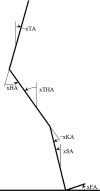Running Technique is an Important Component of Running Economy and Performance
- PMID: 28263283
- PMCID: PMC5473370
- DOI: 10.1249/MSS.0000000000001245
Running Technique is an Important Component of Running Economy and Performance
Abstract
Despite an intuitive relationship between technique and both running economy (RE) and performance, and the diverse techniques used by runners to achieve forward locomotion, the objective importance of overall technique and the key components therein remain to be elucidated.
Purpose: This study aimed to determine the relationship between individual and combined kinematic measures of technique with both RE and performance.
Methods: Ninety-seven endurance runners (47 females) of diverse competitive standards performed a discontinuous protocol of incremental treadmill running (4-min stages, 1-km·h increments). Measurements included three-dimensional full-body kinematics, respiratory gases to determine energy cost, and velocity of lactate turn point. Five categories of kinematic measures (vertical oscillation, braking, posture, stride parameters, and lower limb angles) and locomotory energy cost (LEc) were averaged across 10-12 km·h (the highest common velocity < velocity of lactate turn point). Performance was measured as season's best (SB) time converted to a sex-specific z-score.
Results: Numerous kinematic variables were correlated with RE and performance (LEc, 19 variables; SB time, 11 variables). Regression analysis found three variables (pelvis vertical oscillation during ground contact normalized to height, minimum knee joint angle during ground contact, and minimum horizontal pelvis velocity) explained 39% of LEc variability. In addition, four variables (minimum horizontal pelvis velocity, shank touchdown angle, duty factor, and trunk forward lean) combined to explain 31% of the variability in performance (SB time).
Conclusions: This study provides novel and robust evidence that technique explains a substantial proportion of the variance in RE and performance. We recommend that runners and coaches are attentive to specific aspects of stride parameters and lower limb angles in part to optimize pelvis movement, and ultimately enhance performance.
Figures



References
-
- Ahn AN, Brayton C, Bhatia T, Martin P. Muscle activity and kinematics of forefoot and rearfoot strike runners. J Sport Health Sci. 2014;3(2):102–12.
-
- Alvim F, Cerqueira L, Netto AD, Leite G, Muniz A. Comparison of five kinematic-based identification methods of foot contact events during treadmill walking and running at different speeds. J Appl Biomech. 2015;31(5):383–8. - PubMed
-
- Anderson T. Biomechanics and running economy. Sports Med. 1996;22(2):76–89. - PubMed
-
- Arampatzis A, De Monte G, Karamanidis K, Morey-Klapsing G, Stafilidis S, Brüggemann GP. Influence of the muscle–tendon unit's mechanical and morphological properties on running economy. J Exp Biol. 2006;209(Pt 17):3345–57. - PubMed
-
- Barnes KR, Kilding AE. Strategies to improve running economy. Sports Med. 2015;45(1):37–56. - PubMed
Publication types
MeSH terms
LinkOut - more resources
Full Text Sources
Other Literature Sources

